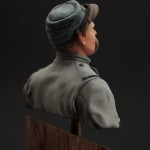
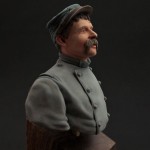
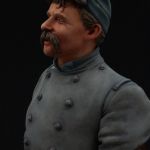
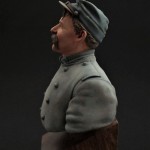
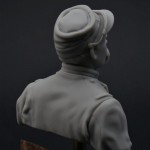
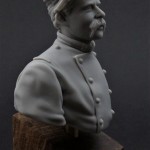
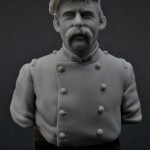
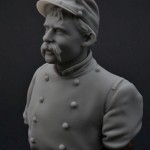
Chasseurs à Pied – French Light Infantryman 1914 / 15 – Chasseurs à Pied – Jäger zu Fuß 1914 / 15
- Scale / Maßstab: 1:10
- Approx. height of bust / ca. Höhe Büste: 60mm
- Material: Resin (bust), 6mm Brass Tube (for bust mount) / Resin (Büste), 6mm Messing-Rohr (für Sockel montieren)
- Parts / Teile: 3
- Infosheet / Infoblatt: English
- Code: 29BUC
Above are photos of my own painted example of this bust, also with resin model pictures. Below are versions painted by David Lane.
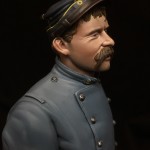
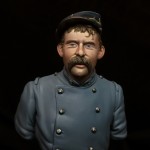
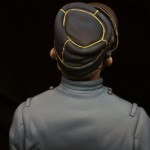
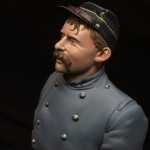
About this Bust
The Chasseurs, or French light infantry were divided into two different types of troops according to their tactical roles. The Bataillons de Chasseurs à pied – or BCP, were classical Infanterie legéré or light infantry and ascended from the 1st Empire. The Bataillons de Chasseurs alpins – or BCA, were mountain troops, originally intended to secure the border between France and Italy, a necessity dating back to the Franco – Prussian war of 1870 when Italy formed her own Alpini battalions in this same area. In 1914 a total of 32 Chasseur battalions were listed, of which 12 were Alpini. The Chasseurs were considered to be elite troops.

The Chasseurs à pied units wore a traditionally dark blue uniform (sometimes described as Chasseur-blue), which consisted of the Model 1877 coat, matching knee high trousers in the same material and the kepi as that of the all the infantry units, but in the same chasseur special colour – blue. Additionally, Chasseur units had yellow (light shaded yellow – jonquille, or narzissgelb) piping and battalion numerals. This Chasseur blue was less conspicuous and more practical than that of their comrades in the French line infantry regiments, then issued with red trousers and red topped kepis. The Chasseurs alpins wore the short, distinctive Dolman-jacket with the same trousers as the Chasseurs à pied but with their characteristic beret M1889.
At the outbreak of war, the enormous logistical difficulties forced the French High Command to simplify the uniform standards of the fighting troops and many historical and traditional characteristics were discontinued. The sudden influx of imported textiles required to meet the new demands (incl. from Britain – gris bleuté), combined with the new standards, meant that many French units within the first months of war appeared much different as they would have done a year or two before. One could say that the Chasseur units generally, with a few exceptions to colour tones and types of cloth, kepi their distinctive appearance, at least until the advent of the Adrian steel helmet and the further uniform and equipment standardisation.
The Bust: the reference material for this character was taken from two photos displaying Chasseurs light infantry mingling with British troops and civilians in a French or Belgium village, probably early autumn 1914 or the spring of 1915. This somewhat dishevelled character is sporting longer hair than would normally be the case and an unkempt moustache, which may indicate an extended period in the front area. The stand-up collar is open at the front and just showing what seems to be a top of a shirt or neck tie. The leather chin-strap to the kepi has become loose and has slipped forward, hanging partly over the cap visor and his right ear. The kepi itself has been pushed back and to one side of the head in a casual fashion. The shoulder strap attachment buttons are slightly off-centre to the top of the greatcoat and lean forward – this can be seen on many contemporary photos of this period. This Chasseur belonged to the 8th battalion, garrisoned at Etain, which at the outbreak of war in August 1914 belonged to the 83rd Brigade (42nd Division, VI Corps).
Kepi for Chasseurs à pied, Model 1884: the Chasseurs à pied Kepi was identical to the French line infantry kepi, but in blue, with a blackened leather visor and yellow (jonquille) piping. The yellow battalion number was mounted on a dark blue cloth backing. The small air vents situated on each side of the upper cap are black coated metal. The blackened leather chin-strap is fastened by 2 small zinc buttons, displaying the light infantry horn. Although an iron-grey / bluish cloth cap cover was issued to Chasseurs à pied battalions, this was generally not worn. Judging by the original photographs and marked difference in shade of greatcoat, the kepi would almost certainly be of the original Chasseur darker blue type.
Note: the gap between kepi and overhanging chinstrap has been filled with a thin layer of resin. This is to help in the casting process and can be removed before painting.
The black chinstraps on original kepis seem to appear with a brownish look, as if the original leather colour is showing through. There is a marked difference between the black of visor and strap.
When fitting the head to the upper body, one should make sure that the bottom of hair at rear of neck is just touching (or slightly above) the stand-up collar.
Greatcoat Modell 1877 / 1914: On each side of the stand-up collar are the green (pre-war in light yellow jonquille) battalion numbers, backed onto a horizon blue base cloth patch – in this case the 8th battalion. The detachable shoulder straps have been removed, leaving the two small fastening zinc buttons displaying the light infantry horn. The same style zinc buttons, but larger were situated at the front of the coat in two rows. Although the correct shade for the Chasseurs greatcoat would be blue, I am of the opinion that the original photos show a much lighter shade (only slightly darker than the British troops shown on the same photos wearing their khaki M1902 Service Dress), indicating a different material being used by the manufactures at the time of production. This may well be a part of the blue-grey cloth supplied by the British in the winter of 1914 (gris de fer bleuté – geblaeutes Eisengrau), identifying the greatcoat as the Model 1914 (also described as greatcoat M 1877 / 1914).
Note: Behind the top of the greatcoat flap and body there is a small casting web – this is to enable a better casting flow and should be removed before painting. The sewn-on regimental patches on the collar have been modelled slightly raised than would normally be the case – this is to enable an easier paint finish. The colour of these greatcoats varied considerably and depended a lot on the type of dye used, origin, wear and tear and age of the garment.
Brass Tube: the 6mm buffed diameter brass tube supplied is to mount the bust to a suitable stand. Under the bust, an appropriate hole has been modelled at the correct angle and position to allow the figure to be displayed appropriately.
 An deutschsprachige Interessenten:
Sie können mich per eMail oder Telefon auch gerne auf deutsch kontaktieren. Ortsbesuch ist nach Absprache möglich.
An deutschsprachige Interessenten:
Sie können mich per eMail oder Telefon auch gerne auf deutsch kontaktieren. Ortsbesuch ist nach Absprache möglich.
